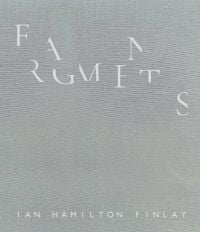
Fragments: Ian Hamilton Finlay – Sfeir-Semler Gallery, Germany
8 May — 30 Aug 2025
We are delighted to present on May 8, 2025 an exhibition marking the centenary of the birth of one of Scotland’s greatest artists, Ian Hamilton Finlay (1925–2006). Fragments is both a major new book and eight exhibitions that will take place internationally during May 2025 in Basel, Brescia, Edinburgh, Hamburg, London, New York, Palma de Mallorca and Vienna, curated and edited by Pia Maria Simig.
An artist, poet and landscape designer, Ian Hamilton Finlay reinvigorated the classical tradition in a body of work that encompasses a variety of creative forms to celebrate the sustaining power of words. He is best known for his garden at Little Sparta, set in the Pentland Hills, near Edinburgh, where he lived and worked for the last 40 years of his life, and for his guillotine installation, A View to the Temple, at Documenta, Kassel, 1987. He significantly influenced the concrete poetry movement, and his extensive printed poetical and graphical works were published by Wild Hawthorn Press, which he co-founded in 1961. His visual artwork, achieved in collaboration with expert artists and craftspeople, can be found in museums, parks and gardens worldwide.
Sfeir-Semler started representing Ian Hamilton Finlay in 1991, holding five solo exhibitions in its spaces in Kiel then Hamburg over the last decades, as well as presenting the work at international art fairs, in group exhibitions, and in instutions worldwide. In Hamburg, his work is in the collections of the Hamburger Kunsthalle and a permanent installation is embedded in the ground in front of its Galerie der Gegenwart: a sentence in German that reads Heimat is not the land – it is the communion of feelings. An extensive show celebrated his oeuvre at the Deichtorhallen in 1995.
At a moment when democracy is challenged around the world, the exhibition in Hamburg focuses on a body of work centered on the French Revolution of 1789. Because Finlay never shied away from the ambiguities of history, he recognized that the pursuit of a better world is often entangled with violence and bloodshed, and many of his works present revolution as a necessary force for societal transformation. Installations such as Thermidor or Women of the Revolution pay tribute to figures of the French Revolution who lost their lifes for the sake of change, for example.
Merging the revival of classical iconography with minimalist conceptual typography, Finlay’s work stages complex and often violent episodes of history—from antiquity to the French Revolution and the Third Reich— asserting that any vision of beauty or harmony must reckon with, rather than exclude, the contradictions and conflicts that shape it. Above all, Finlay interweaves nature throughout his installations—paying tribute to a constant, ideal, presence that, in his view, will outlast all humanity.
Please log-in or create an account to see your recent items.